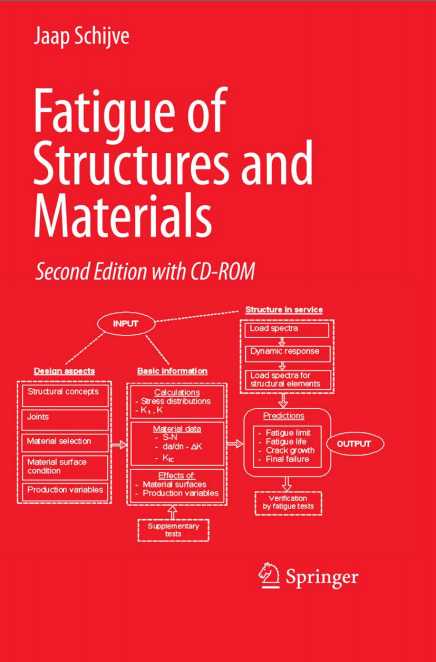Fatigue of Structures and Materials

Jaap Schijve
Fatigue of Structures
and Materials
Second Edition with CD-Rom
Fatigue of structures and materials covers a wide scope of different topics.
The purpose of the present book is to explain these topics, to indicate
how they can be analyzed, and how this can contribute to the designing
of fatigue resistant structures and to prevent structural fatigue problems in
service.
Chapter 1 gives a general survey of the topic with brief comments on
the significance of the aspects involved. This serves as a kind of a program
for the following chapters. The central issues in this book are predictions
of fatigue properties and designing against fatigue. These objectives cannot
be realized without a physical and mechanical understanding of all relevant
conditions. In Chapter 2 the book starts with basic concepts of what happens
in the material of a structure under cyclic loads. It illustrates the large
number of variables which can affect fatigue properties and it provides the
essential background knowledge for subsequent chapters. Different subjects
are presented in the following main parts:
- Basic chapters on fatigue properties and predictions (Chapters 2–8)
- Load spectra and fatigue under variable-amplitude loading (Chapters
9–11)
- Fatigue tests and scatter (Chapters 12 and 13)
- Special fatigue conditions (Chapters 14–17)
- Fatigue of joints and structures (Chapters 18–20)
- Fiber-metal laminates (Chapter 21)
Each chapter presents a discussion of a specific subject. The major aspects
are recapitulated in the last section of a chapter, not as a summary, but
just as the most important points to remember. In spite of a qualitatively
good understanding of the fatigue phenomenon in structural elements, the
quantitative accuracy of the prediction of fatigue properties can still be
limited. As a consequence, it is important that all relevant issues are well
recognized and understood. This was one of the major reasons for writing the present textbook.
Download
*